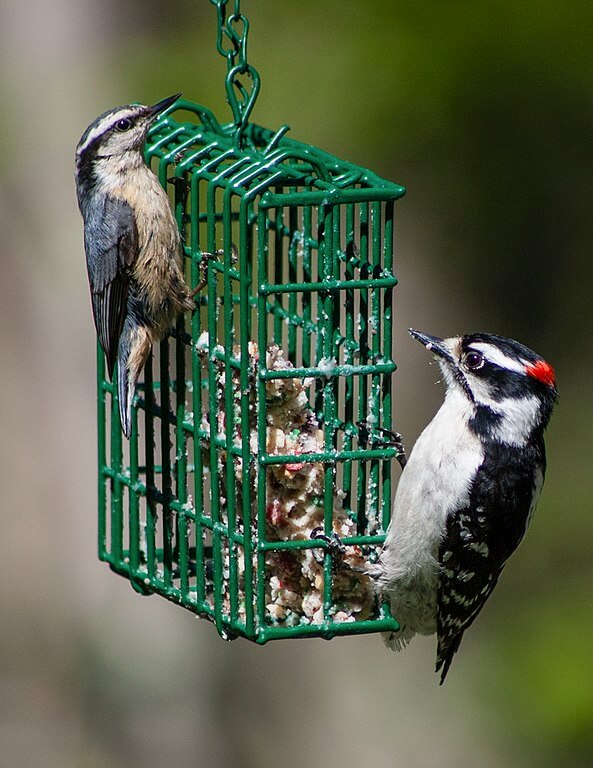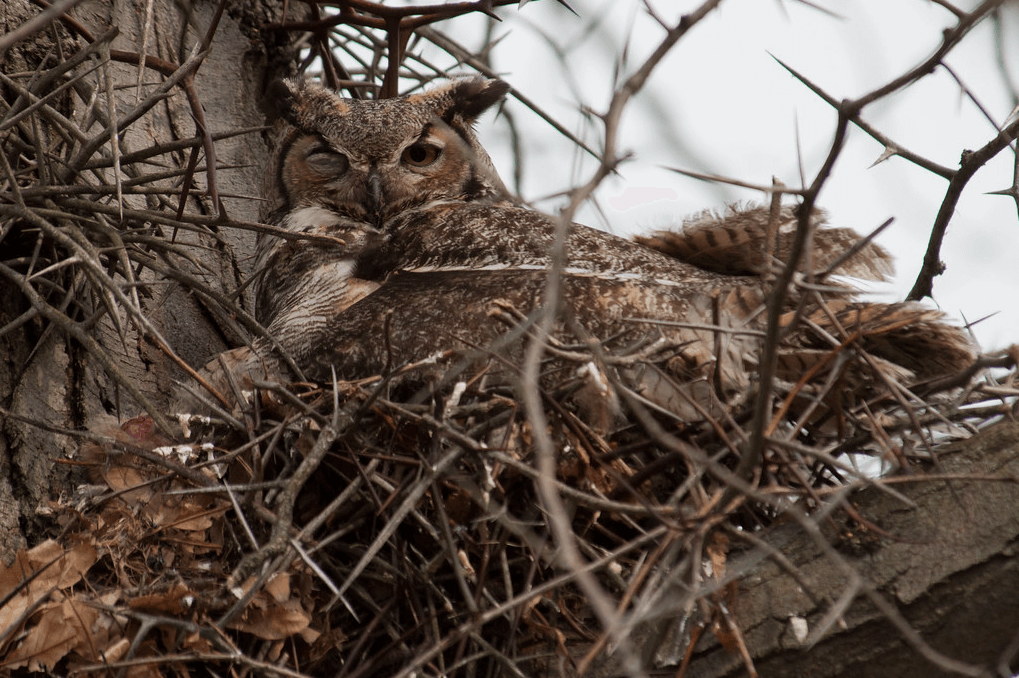A Year of Birding in My Backyard
By Elena Ulev
Broadcast 3.9 & 3.12.2022

A Red-breasted Nuthatch and Downy Woodpecker share a suet feeder. Photo by Paul VanDerWerf, CC 2.0.
Listen:
Bird surveys in my backyard. I look forward to doing them every morning when I wake up. What species will I get today? Will anything new visit or fly over my acre while heading towards the Bitterroot River? Every day for one year, I spent 10 minutes counting bird species on my property no matter the weather—snowstorms, 100-degree heat, heavy rain. I found that some birds call my yard home year-round and some have appeared only once and I was lucky enough to see them.
Spring
To me, spring officially arrives when I hear the first Ruby-crowned Kinglet singing its long melodious song ending with “peeter-peeter-peeter peet!” This is usually the end of March. The Western Meadowlark’s sweet song also reminds me that the solemn gray winter has finally ended. House Wrens compete with Red-breasted Nuthatches and House Sparrows for the best real estate in the yard: a nest box mounted to a fence post protected by the cover of a 30-year-old apple tree. Who will win the coveted spot this spring? (The House Wren did.)
Summer
In the evenings I eagerly listen for Common Nighthawks’ “peent!” call from high overhead. One peculiar time I found thirteen circling just above my hill. They were flying low enough to see their white throat patches, which was unusual. I had watched them for a long time when I noticed that one was missing its tail! It had a fantastic set of long, aerodynamic wings, allowing it to fly just as well as the others, but it was clearly missing an important piece of its body. A friend who studies nightjars told me that they sometimes “shed” all of their tail feathers when under stress. Common Nighthawks are already weird creatures but shedding their tail really takes the cake.
Fall
Mystifying honking from a mile away, coming closer—I see them! Sandhill Cranes, their outrageously huge wingspans allowing them to fly gracefully together in a “V,” instinct sending them far away. Good luck, I wish them. See you again in a few months.
I lose the songs and the sights of the migratory songbirds one by one: the robins, kinglets, the Calliope Hummingbirds that love the bee balm I planted for them in my garden.
Winter
I seem to notice the most bird activity in my backyard in the winter. The neighborhood is quieter, my mind is quieter, I have more time on my hands. I sit in my sunroom painting at a small table pushed against the sliding glass doors and look up occasionally at the five fruit trees and suet feeders hanging from them. Just about every day, a mixed flock of Pygmy and Red-breasted Nuthatches, Black-capped Chickadees, House Finches, American Goldfinches, Dark-eyed Juncos and sometimes a Downy Woodpecker appear, flitting around excitedly. Everybody has their place—the juncos feed on the ground underneath the huge Douglas-fir, the nuthatches and woodpecker excavate bigger holes in the dying cherry tree, the finches perch at the tops of the trees, sentinels for a potential Merlin or Sharp-shinned Hawk, and the chickadees hang from the feeders. They stay for only around 10 minutes (long enough for me to tally everyone) then move on together somewhere unknown.
Red Crossbills seem to love snowstorms, where I count up to 60 individuals “kip-kip-kipping” as they fly together. Occasionally they land in the massive ponderosa pine trees and voraciously devour the pine seeds, twisting them open with their bizarrely shaped bills. I can hear as well as see the seed husks fall to the ground like papery rain.
Over the course of 365 days, I tallied 65 bird species in my yard. Some, such as a Northern Pygmy Owl, a Lewis’ Woodpecker, and a Wilson’s Warbler, appeared only once, while others, such as a pair of Eurasian Collared Doves and several House Finches, I saw every day. So much is going on in our own yards if we spend a little time devoted to mindfully observing. So, go ahead, strap on a pair of binoculars, pull up a lawn chair, and enjoy the show.
Every week since 1991, Field Notes has inquired about Montana’s natural history. Field Notes are written by naturalists, students, and listeners about the puzzle-tree bark, eagle talons, woolly aphids, and giant puffballs of Western, Central and Southwestern Montana and aired weekly on Montana Public Radio.
Click here to read and listen to more Field Notes. Field Notes is available as a podcast! Subscribe on iTunes, Google Play, or wherever you listen to podcasts.
Interested in writing a Field Note? Contact Allison De Jong, Field Notes editor, at adejong [at] montananaturalist [dot] org or 406.327.0405.
Want to learn more about our programs as well as fun natural history facts and seasonal phenology? Sign up for our e-newsletter! You can also become a member and get discounts on our programs as well as free reciprocal admission to 300+ science centers in North America!












